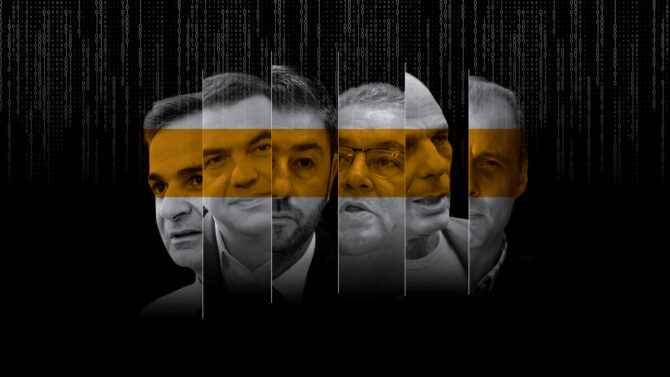An analysis of the pre-election political discourse in Greece

We are using AI algorithms to detect the levels of polarisation, populism and emotion in the speeches of political leaders.
Rather than studying polarisation itself, this project aims to examine the discourse of polarisation – that is, to determine whether political discourse contains rhetorical and discourse patterns that seek to create a sense or condition of polarisation at the socio-political level.
The Greek elections that took place in May and June of 2012 were dubbed a “double electoral earthquake.” These elections marked the end of two-partyism that had been in place since the Metapolitefsi (regime change) era and set off a complete restructuring of the party system. Fast-forward eleven years later, we find ourselves once again faced with the possibility of a two-round voting process, only this time, the second round is already taken for granted. The expectation of a double vote has created a sense that we will be entering a particularly polarised political landscape. This assumption seems quite reasonable and, as such, merits further exploration in the current election period.
A certain level of polarisation is plausible or even necessary in a political system
Polarisation is nowadays considered as a critical feature of contemporary political systems in the West, and is often depicted as an unfavourable phenomenon in public discourse. However, it is important to note that a certain level of polarisation, in terms of differentiation and competition, is plausible or even necessary in a political system. To engage in a more detailed discussion regarding polarisation and its potential consequences, it would be useful to start with a rough distinction between concepts that appear similar, such as competition and division.
Politics inherently encompasses an antagonistic dimension, and democratic politics involves the selection between different policies, competing agendas, and conflicting visions. Within the political realm, interests, ideologies, perceptions of the world and the future, identities, and passions collide.
Populism in pre-election political discourse in Greece

Populism is not equivalent to politicians’ falsehoods, promises, or deceitfulness. It is not synonymous with demagoguery, propaganda, or manipulation.
The ideological “left versus right” cleavage has prevailed in Greece for many years
In every society, there are traditional divisions. Our societies have never been homogeneous, as social stratification and competing collective identities always manifest themselves in the political sphere. Class division is the most commonly discussed and continues to play a significant role in today’s political arena. One approach that examines divisions at the social and political level is cleavage theory. Within this theory, cleavages are seen as relatively stable political rivalries based on significant social divisions. Cleavages have served as a foundation for the creation of party systems, particularly in western, central, and northern Europe, and they are the parameters that define the framework for political competition. The traditional cleavages that have been identified include:
1. Centre-periphery (cultural cleavage)
2. State-church (religious cleavage)
3. Rural-urban cleavage
4. Workers-owners (class cleavage).
For reasons beyond the scope of this article, the ideological “left versus right” cleavage has prevailed in Greece for many years.
It is apparent that polarisation shares some commonalities with the aforementioned concepts, but it also differs in other respects. According to Sani and Sartori, polarisation refers to the ideological distance among parties. It reflects the intensity of their opposing political ideologies and party identities.
When polarisation becomes acute, it can pose a risk to pluralism and encourage fanaticism
We could say that a public sphere is politically polarised when strongly divergent party or ideological divisions are promoted and entrenched in it. The two political and ideological stances that form the basis of polarisation are presented as incompatible, leading to a clustering of citizens’ political views and attitudes around the two opposing positions. As a result, a strong and irreconcilable divide is created between the two camps, with some extreme cases even involving attempts to challenge or even reject the legitimacy of the other camp.
When a discourse seeks to increase polarisation, it portrays politics in binary terms and divides society into two opposing camps. Often, it is based on entrenched social identities or divisions that endure over time and emphasises opposing pairs of concepts and values, such as modernisation versus tradition, progress versus preservation or traitors versus patriots. This point is crucial not only for politics in general, given its inherently antagonistic nature, but also for specific types of political practice. However, these features are not exclusive to polarising discourse and can be found in other forms of political practice. Another feature commonly found in polarising environments is the strong emotional dimension of political discourse. Therefore, identifying polarisation requires careful consideration of the wider context by researchers.
When polarisation becomes acute, it can pose a risk to pluralism and encourage fanaticism. This, in turn, may lead to the exclusion or marginalisation of moderate or alternative viewpoints from public discourse. As a consequence, smaller political parties may also face marginalisation or exclusion from the political process.
When analysing political polarisation, there are various dimensions that can be examined. One way to do this is to analyse ideological and programmatic polarisation by studying the activities and policies of political parties. We can look at polarisation at the level of political attitudes through public opinion surveys and explore on which issues the electorate is value-polarised. Socio-economic polarisation can be assessed by examining indicators of inequality that show how inequality affects political attitudes and voting behaviour. Demographic or generational polarisation can also be studied by comparing attitudes and behaviours across different groups, based on factors such as gender or age. Furthermore, a broader socio-political polarisation can emerge when a particular issue dominates the public sphere and creates a clear divide within society, as seen in debates over issues such as the Memorandum or the Prespa Agreement. Finally, we can focus on electoral-party polarisation, which can be traced to the rise of two-partyism and the diminishing appeal of smaller parties, and is reflected in the rhetoric of political parties.
In the lead up to the 2019 elections, Professor of Social Theory Kyrkos Doxiadis argued that “objectively identifying or measuring polarisation at the political level is questionable in terms of its validity.” We agree with this view, as political and social phenomena do not manifest in the same way as natural or chemical phenomena. Rather than studying polarisation itself, this project aims to examine the discourse of polarisation – that is, to determine whether political discourse contains rhetorical and discourse patterns that seek to create a sense or condition of polarisation at the socio-political level.
